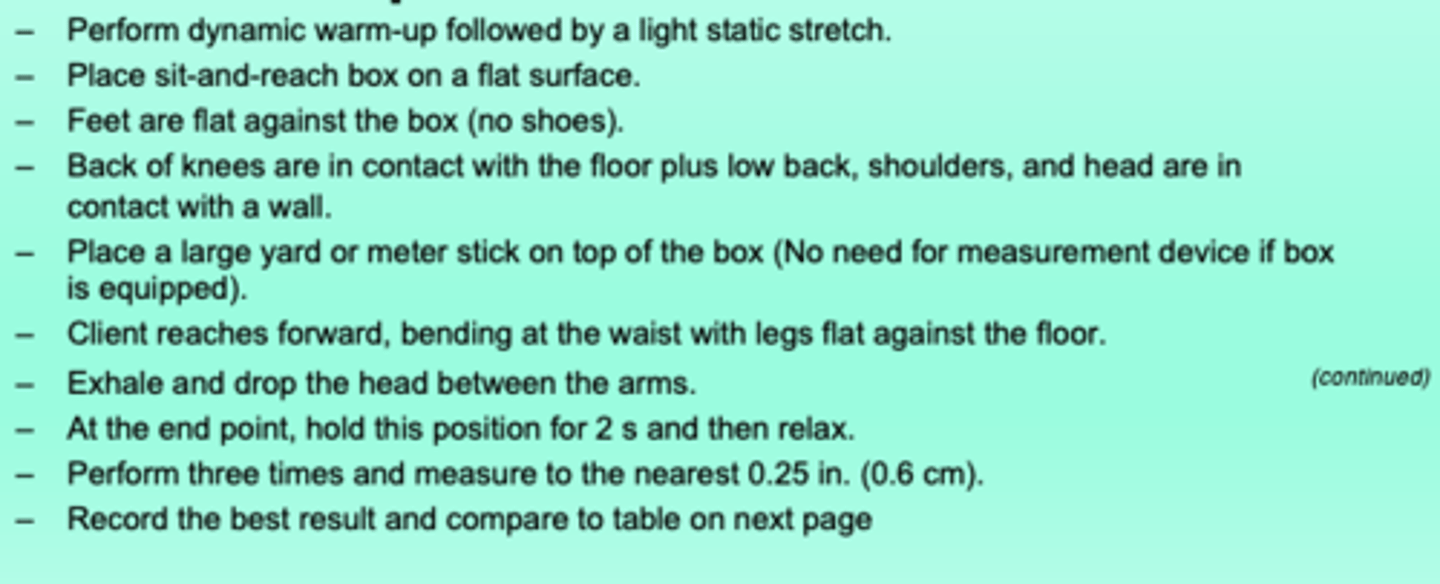APK4125 Lab 10: Balance Assessments
1/45
There's no tags or description
Looks like no tags are added yet.
Name | Mastery | Learn | Test | Matching | Spaced |
|---|
No study sessions yet.
46 Terms
Balance is a key component of ? fitness
functional
Balance is recognized as a ? component of fitness
skill-related
Balance demands high levels of other components of fitness such as: (4)
strength, flexibility, reaction time, coordination
For seniors, balance is extremely important to maintenance of ? and successful completion of ?
-independent living status
-ADLs
Balance training helps prevent ?
falls
Balance is the ability to keep the body's ? within the base of ? when maintaining a ? position, performing ? movements, or reacting to external ?
-center of gravity (COG)
-support
-static position
-voluntary
-disturbances
3 types of balance
static, dynamic, functional
Static balance is the ability to maintain ? within the support base while ? or ?
-COG
-standing or sitting
Dynamic balance is maintaining an ? position while COG and base of support are ? and the COG is moving ? the supporting base
-upright
-moving
-outside
Functional balance is the ability to performing ? requiring balance
daily movement
The further the COG from the base of support, the ? the stability
lower
The broader the base of support, the ? the stability
higher
? training and ? programs increase the ability to maintain and improve balance through improving ?
-resistance training
-stretching programs
-stability
Exercising on ? surfaces can challenge balance response and provide ?
-unstable
-variety
?, ?, and ? training programs are more effective than ? training for reducing risk of falling
Balance, resistance, and flexibility
-endurance
Generally, programs include a mix of ?, ?, ?, ?, and ? exercises
balance, resistance, flexibility, resistance, and plyometric
Many balance test batteries are ? and include multiple test items to assess both ? and ? balance
-comprehensive
-static and dynamic
Direct measures of balance may be obtained using ?
computerized force plate devices
Tests that assess static balance using indirect measures
-Romberg
-Unipedal
-Clinical test of sensory integration of balance
Tests that assess dynamic balance using indirect measures
-Functional reach tests
-Timed up and go tests
-Start excursion balance test
Romberg tests measure ? balance while standing with eyes ? and ?
-static
-eyes opened and eyes closed
Unipedal stance test is a timed ? stance test that provides simple measures of ? balance
Two conditions: ?
Multiple ?
-one-leg
-static
-eyes open, eyes closed
Multiple variations: flamingo, stork, etc.
Clinical test of sensory integration of balance evaluates the contributions of the ?, ?, and ? sensory systems to balance
visual, proprioception, and vestibular
Functional reach tests measure ? distance one can reach beyond an ? without losing balance or moving the ?
-maximum
-arm's length
-feet
Timed up and go tests assess ? balance and ? of older adults
-dynamic
-agility
Star excursion balance test (SEBT) provides a significant challenge to ? and ? individuals
-athletes
-physically active
Y Balance Test allows us to ? the body and look at how the ? and each ? function under body weight loads
-quarter
-core
-extremity
Y-balance test device and protocol can be used for measuring ? performance, improvement after ? programs, ? balance for fitness programs, and return to ? readiness
This device and protocol can be used for measuring pre and post rehabilitation performance, improvement after performance enhancement programs, dynamic balance for fitness programs, and return to sport readiness.
Y-balance test is a modification of the ?
Star excursion balance test (SEBT)
Two parts of the Y-balance test
1. low quarter (YBT-LQ)
2. upper quarter (YBT-UQ)

Y-balance test additional information
Testing: ? attempts--> ? trials recorded and ? faults
Practice attempts: ?-?
Asymmetries
-anterior: >?cm between limb on each side
-posterior: >?cm between limb on each side
Testing: 5 attempts--> 3 trials recorded, 2 faults
Practice attempts: 6-8
Asymmetries
-anterior: >4cm
-posterior: >6cm
Y-balance test composite score equation
Equation (composite score): [{anterior + posterior lateral + posterior medial) / 3(limb length)] * 100
Limb length: ASIS-->medial malleolus
Y-Balance Directions: Testing Order (3 trials each)
-right anterior reach
-left anterior reach
-right posteromedial reach
-left posteromedial reach
-right posterolateral reach
-left posterolateral reach
**posterolateral is essentially a curtsy lunge
Test faults (4)
-kicking push box
-not returning to starting position under control
-touching down during reach
-foot on top of stance plate
Muscular flexibility is a component of ?
health-related fitness
Flexibility is defined as ? of a joint or group of joints, as per the ? and not any ? forces
-ROM
-skeletal muscles
-external
Static flexibility can be achieved through the use of ?, a ?, or specific ?
-gravitational force
-partner
-specific exercise equipment
Dynamic flexibility is the full ? given joint achieved through the ? use of skeletal muscles in combination with ? forces
-ROM
-voluntary
-external
ROM of one particular joint may not predict the ?
ROM of other joints
One assessment (can/cannot) tell you overall ROM for an individual
cannot
Goniometers are similar to a ?
protractor
Goniometers are used to measure a joint's ? expressed in ?
-range of motion
-degrees
A goniometer consists of 2 arms:
-a ? arm that is ? to the proximal body segment
-a ? arm that follows the ? body segment as it is moved through its ROM
-a stabilization arm that is fixed
-a movement arm that follows the distal
The axis of the goniometer is placed at a ? anatomical landmark, generally at the joint ?
-predetermined
-axis of rotation
Sit-and-Reach test is a ? measure of ? flexibility of ? back and ? group
-indirect
-static
-lower
-hamstring
Sit-and-Reach procedures
